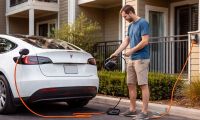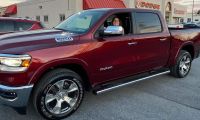The electric vehicle (EV) market in the US enjoys subsidies from the US taxpayer in so many ways they are almost uncountable. Rather than pick apart the Zero Emissions Vehicle credit and direct subsidies that are often hidden from the consumer, like when the taxpayers of Maryland paid the factory utility costs for Fisker, let’s just look at the most obvious and easily understood subsidies. That being the $7,500 federal EV tax credit and $2,500 state refund that most EV buyers are offered. Let’s ask ourselves why these subsidies are in place and if the reasons are sound.
The primary reason most people and state agencies give for these types of taxpayer funded subsidies is that without them the cars won’t sell. Meaning won’t sell at all, or won’t sell robustly enough for the manufacturers to consider the vehicles viable. At a recent clean transportation promotional event this month the Governor of the Commonwealth Massachusetts touted a new $2500 direct rebate to EV buyers. In a Worcester Telegram article explaining why these types of funding programs are necessary, John O'Dell, senior editor and green car expert at Edmunds.com (a publication we respect), was quoted as saying. "Anything that makes a purchase less expensive helps. Electric (vehicles) aren't selling as well as some hoped they would."
This statement is typical of the opinion of EV advocates, which is why it was well suited to the story about Mass. deciding to give EV buyers some money. However, is it factual? Are EVs not selling because they cost too much and will “Anything that makes the purchase less expensive help make EVs sell the way advocates hope?” Let’s look at the two leading electric cars in America.
The Tesla Model S and the Nissan Leaf are the number one and two top sellers of cars powered by only electricity. The Chevy Volt does well, and its sales are about equal to those two models, but it has a gasoline engine. Many argue it is not an electric vehicle, so we will skip it as an example. In any case, only these manufacturers have so far fully committed to making an EV and selling it in whatever volume customers will take. BMW's new i3 is coming to market this month. We expect it will be a huge success.
The Tesla Model S is described by company founder Elon Musk as the best car in the world. Not the best EV, the best car period. He also recently proudly announced he would not sell the Model S in China for the market price, but at a lower price because he wanted to be fair. According to the company’s website the car’s starting price, without navigation, with the shortest range battery, and the lowest power, is $71,070 including delivery charges (mandatory). You may have heard a lower number quoted, but that is always after the tax rebates and direct state tax rebates. The fully loaded Model S costs over $130,000. This is a supercar that can beat a 2014 Corvette Stingray in a drag race and at the same time be a luxury car that Tesla compares to the Mercedes Benz flagship model, the S-Class.
Currently the Tesla Model S has a waiting list of customers of one to six months. It has been that way now for three model years (sales started in 2012). People are literally lining up to buy the car at this very high price. In fact, Tesla says it is the number one selling car in its class based on total sales. We checked. They are correct. Yet, the car comes with a $7,500 tax break and many states feel the need to give Tesla buyers a direct rebate check for between $2,500 (California for example) and $5,000 (Georgia). Why? Tesla is selling all it can build in its state of the art factory and has a huge line of people waiting to get one.
The Nissan Leaf is a much more modest car and sells in the range that most cars do. Sales are robust. A couple examples of popular cars in its price range that it outsells include the Mazda Miata and Scion FR-S.
The 2014 Nissan Leaf starts at $28,980 (before the federal tax rebate) and with the top trim features it maxes out at about $36,920. The engine and battery are the same on the base and fancy version. So the difference between the base Leaf and the one with the super fancy bits is $7,940. That is more than the federal tax rebate. In effect, isn't the federal tax rebate to any buyer of that fancy Leaf simply a federal subsidy for the luxury package? By the way it includes a built-in navigation system, leather appointed seats (made from real cows), Bose premium audio, automatic headlights, upgraded alloy wheels, and a feature that Nissan calls “Carwings?”
If you think this story is simply EV bashing by a gas-car nut whose thinking is outside the norm, guess again. Green Auto Blog reports that California, the birthplace of EV subsidies, is considering putting a cap on the $2,500 it gives EV buyers. The cap proposed this week would be set at an MSRP of $60,000. That means it would only apply to two models of EVs. The Tesla Model S and the Cadillac ELR. The idea of stopping rebates for EVs that are expensive and/or sell well has now been put on the table by the very people who thought up this scheme.
Subsidizing the electric car so it can be viable is a reasonable concept. However, looking at the reality of the two top EVs in terms of sales, one is selling like gangbusters at prices most Americans can never dream of spending on a car, and the other outsells many popular car models and appears to have a luxury package almost exactly equal to the subsidies meant to make these cars affordable.
Here are some recent stories written by EV friendly websites about EV sales:
Electric Vehicles Speeding Toward 7% Of All Global Sales By 2020
Why U.S. electric vehicle sales are booming
Electric Car Sales Increased 228.88% In 2013













Comments
I can't exactly agree here. I
Permalink
I can't exactly agree here. I don't see how a Leaf having options that are covering the subsidy unless you can point out that most Leafs sold have all options. The Leaf probably offer luxury options simply because lack of an Infiniti EV.
But I will somewhat agree about the overall usefulness of the subsidy tax credit. The reason is while it may reduce the upfront cost, in the end, the car instantly loses that subsidy in resale value. So when you buy that Volt for 35k in California, the moment you drive off that lot it is like driving off in a 25k car. There is no win for the consumer here at all. A more efficient policy which would have exact same effect would be to pass a regulation requiring that car dealers and manufacturers require that "True Cost To Own" be put on every car and force dealers when they mention price to always mention the TCO. It can be based on the average 6 years of a new car.
Since math is not people's strong point they only look at sticker price. So the subsidy helps there. But the same effect can be had by posting the TCO on every car. I mean the reality is people don't buy the sticker price anyways, they finance their car. So what does it matter to them the sticker price? What matters is the monthly payments really. A car with higher sticker price can be cheaper then a lower one just by having a lower TCO.
To be honest, Out of all the subsidies I think ZEV credits are much more efficient method of subsidy. Sure it forces manufacturers to make junk compliance cars. But at least it gets them to get their feet wet in the water so they get experience in making them and might be more able to push out a real product in the future. The biggest weakness of the ZEV credits is it is too lenient.
EV subsidies are simply crony
Permalink
EV subsidies are simply crony capitalism, a form of welfare for companies who leverage political pull to line their pockets. Most of Tesla's so-called profitability is a phantom: without the hundreds of millions in rebates to consumers AND carbon credits they sell to other "polluters" in California, they would have no viable business model. Taxpayers are being soaked, first by environmentalists who want gas and electricity to cost more, and then by tax-code exploiters who have turned the electric car io the "government subsidized railroads" of the 21st century....
That is simply nonsense.
Permalink
In reply to EV subsidies are simply crony by Matthew (not verified)
That is simply nonsense. First of all, most of the returns to consumers are in the form of non-refundable tax credits, not rebates. Second of all, the California ZEV credits are NOT carbon credits. ZEV credits govern pollution such as NOx(acid raid and smog), O3(lung damage) and etc. Your car can give off nothing but CO2 and still receive California ZEV credits.
That said, in the case of Tesla, the non-refundable tax credit is insignificant. It only make up 6-10% of the car cost and Tesla is supply capped, not demand capped. With or without it makes no difference for the time being. And if you have seen their 2013Q4 finances, they reported record quarter while making 0$ in ZEV credits.
And if your really wanted to avoid taxes, that is what Cayman and Cook Islands are for. Buying an electric car is the silliest and unrealistic way to go about it.
There are a range of
Permalink
There are a range of excellent reasons why governments around the world are subsidizing electric vehicles and no it isn't a Greenie conspiracy. First there are the health reasons for retiring the toxic gas fleet which causes millions of deaths annually and costs health services billions of dollars annually in medical costs for respiratory and coronary diseases. That is an externalised cost to the community and every tax payer is paying for it - in effect a subsidy to the oil industry. Then there are the strategic reasons to encourage a move away from reliance on imported oil from politically volatile areas of the world - mainly the middle east. It is high risk to any nation's economy to rely on it's energy sources from another region but especially from a region that is a powder key. Then the economic reasons - it's cheaper for a nation to use it's own energy resources to power it's fleet than to spend it's money on foreign oil imports. The environmental reasons to subsidize electric vehicles is simply icing on the cake for any country that provides subsidies. The health, strategic and economic reasons are the main reasons why almost all industrialised countries are encouraging their citizens to ditch gas powered cars. Oil is becoming more difficult to extract and more expensive to do so. That situation is not going to change. The quicker a government can change its toxic fleet to a clean (localised emission free) fleet the cheaper it becomes from a health and energy cost perspective while lessening the reliance on high risk energy sources. Read more if you like at myelectriccar.com.au where all these issues are discussed.
All excellent arguments,
Permalink
In reply to There are a range of by Electric Leo (not verified)
All excellent arguments, right out of the environmental lobby handbook. However, let's say I agree with these objectives completely and whole-heartedly. Step back and ask what the point of the subsidies are. The Tesla is sold out, and has been sold out since it was introduced in 2012. Most recent Tesla club posing about a new owner getting a car said he waited 6 months to get one. That was posted Monday. So is the subsidy necessary to achieve your (our) goals above with regard to that top selling EV? Apparently not. If not, then why not deploy that money in another more useful way to meet your (our) goals, or not get involved. The Leaf is selling robustly, outselling many cars people consider successful. I show 3 links at the bottom of the story, plus two more in the main body of the story all from green-car and environmentally pro-active websites. All three agree EVs are selling very well. Is the subsidy needed? Is it doing anything to help the Leaf and Model S to sell, or are the subsidies simply giving people money for the sake of a good idea and so they can have premium audio and leather seats at no cost?
John - I don't happen to have
Permalink
In reply to All excellent arguments, by John Goreham
John - I don't happen to have an environmental lobby handbook but feel free to send me one if you have a copy. I don't disagree with the points you make either. Subsidies have been necessary to kick start the sale of electric cars - if sales are so stellar then perhaps it is time to phase them out but this is still a very new industry and I'm sure as it gains traction subsidies will be done away with having accomplished what they set out to do. Electric cars are still very expensive when compared to convention internal combustion engine vehicles so until economies of scale kick in and battery prices drop further it may still be prudent to entice consumers to make the switch.
More to the point are the subsidies the oil industry currently enjoys. This is a mature and highly profitable industry that still imposes on the tax payer in a much bigger fashion than the relatively tiny subsidies of EVs. Billions in health care costs and environmental damage. Billions spent on wars to secure supplies. Its time for the true costs of burning a valuable resource to be factored in to the equation - taking pot shots at the EV industry is a distraction.
Wow John, you appear to be
Permalink
In reply to All excellent arguments, by John Goreham
Wow John, you appear to be suffering from a severe case of EV-tunnel vision. Let's broaden the picture. While I agree with you that the " S" will sell with or without subsidy, I've yet to meet a well heeled consumer that doesn't appreciate a tax incentive to purchase a durable good. Housing is a prime example. It's been estimated that with the proposed death of the mortgage loan interest credit, the real estate industry would be dead. I do believe that $10,000 does make a difference to the Tesla buyer. Reasoning: For one, despite the " green" implications, a tax incentive makes for great dinner table conversation and country club bragging rights. For the rest of us... I believe that the tax incentive was put in place as an incentive "hook" for manufacturer's to jump on board. As well as, an incentive for manufacturers to broaden the development and expansion of affordable EV's personal transportation for the middle class. Note, I haven't included most of America in this statement. The majority has no use for an electric car or the subsidy that is attached to it. From a Tax standpoint, most American's pay very little if any Federal income tax. That's the real story here. While billionaire's toy with the development of high end EV,s much of America is confined to the middle seat of any-town U.S.A.'s transit system. Looking to the( real) numbers of EV s sold in North America, they're simply a blip on the screen of viable, alternative( hybrid) personal transportation. Thanks for the informative read.
"...millions of deaths
Permalink
In reply to There are a range of by Electric Leo (not verified)
"...millions of deaths annually and costs health services billions of dollars..."
I just couldn't read any further. Because, you know, electricity is created with pixie dust that outputs no pollutants, and batteries are edible.
There are many ways to
Permalink
In reply to "...millions of deaths by Matthew (not verified)
There are many ways to generate electricity. Yes there are fossil fuels such as NG and Coal, and in rare cases oil. But there is also other options such as Nuclear, Solar Thermal, Solar PV, Hydro, Tidal, Geothermal, Wind and etc.
And I am guessing you have seen the part where BYD CEO drank a lithium ion battery too?
I agree that Tesla doesn't
Permalink
I agree that Tesla doesn't necessarily need the subsidy (see my article that will be up as soon as our editor notices I posted it). However, I don't think there is an argument about the LEAF; its sales would suffer dramatically without incentives. Just look at the sales bump the LEAF saw after they dropped the sale price by $4,000 or whatever it was when production was shifted to the US last year. My parents own a LEAF, and there is absolutely no way they could have bought it without the subsidy. Anecdotal evidence I know, but the typical LEAF buyer relies on rebates and subsidies much more than the average Model S buyer. The bottom line, unfortunate as it is, is that mass-market EVs are not yet cost-competitive without incentives. I believe they will be, maybe within 5 or 10 years, but they're not there yet.
Tesla may not necessarily
Permalink
In reply to I agree that Tesla doesn't by Luke Ottaway
Tesla may not necessarily need the subsidy, but since cost was the primary deterrent in me buying a Tesla Model S, I certainly needed the subsidy, both the Federal $7,500 and no sales tax on EVs from WA State. I wonder how many other Model S owners feel similarly.
Thank you Charlotte.
Permalink
In reply to Tesla may not necessarily by Charlotte Omoto (not verified)
Thank you Charlotte. Excellent point. We value your readership as you know. Just in case it is not apparent, we have a new EV writer, Luke, and he wrote the counterpoint story to this one. If you click our electric vehicles tab at the top of the main TN page you will be directed to all the green car related stories in one place. Luke will be covering most Tesla topics for a while. When we do opinion pieces like this one we are trying to also offer a full story from a different angle. For straight up news on Tesla Luke will be doing the majority of the stories for a while. Thanks for reading. Your input helps us keep it real.
I agree with the folks in
Permalink
I agree with the folks in California. A price cap is a good idea. Anybody buying a $100,000 car does NOT need to collect the $7500 rebate to make the sale. Rebates hurt used car/trade in values. Its also an important point but not all EV buyers will qualify for the full $7500 but the drop in resale value does assume everybody gets it..
What I don't understand is
Permalink
What I don't understand is why this article is posted under Tesla and not also Nissan?
Oversight. Thanks
Permalink
In reply to What I don't understand is by Charlotte Omoto (not verified)
Oversight. Thanks
The Hummer H2 received
Permalink
The Hummer H2 received subsidies, so the answer is EVs currently receive subsidies and the legislation will most likely not be extended. If the car companies believe the subsidies will be around after the meet their limits then EVs will go the way of the Hummer!!! The real issue is what to do about the 50 cent a gallon gas tax, because EVs will win out.
Oh don't worry about the
Permalink
In reply to The Hummer H2 received by Gene Frenkle (not verified)
Oh don't worry about the taxes. The good folks in Virginia (and several other states) slap a $64 surcharge on the registration cost to cover the loss in Road User Taxes. Its just a matter of time until the Feds do the same.
These rebates and tax offsets
Permalink
These rebates and tax offsets to the buyer are an indirect passthrough subside to the car maker. They allow the maker to sell the car at a higher price. Subsides are the people's money and should be temporary and phased out asap. Otherwise, they distort the very market they are designed to stimulate and become an assumed offset for the continuing cost of the product. Look at the Oil Industry. Without the ongoing subsides, drivers could not afford the price of fossil fuel to power their cars.
That's a good point. The
Permalink
In reply to These rebates and tax offsets by Lad (not verified)
That's a good point. The current federal subsidies are and were always intended to be temporary; the current subsidies are set to expire for each manufacturer once they reach the target of 200,000 electric vehicles sold. At that point the tax credit will be phased out for that automaker over a 1-year period. Rather than time-based, this strategy aims to wean the EV industry off the subsidies when it is ready to venture out on its own.
Although I am very strongly
Permalink
Although I am very strongly in favor of electric vehicles I am disgusted that my hard earned tax dollars support savings for rich people who buy a 70,000 dollar plus car. If you can afford 70,000 for a car you don't need my tax dollars. Furthermore, my tax dollars not only subsidize the well to do purchasers of a Tesla, they also indirectly subsidize the company shareholders who already do not pay their fair share of tax on investments. (Versus earned wages). Set a price limit on the vehicles to which the subsidy can be applied. Not only would this be "fair", it would encourage vehicle manufacturers to build cars at a sale price under that threshold.